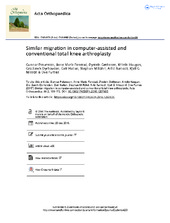| dc.contributor.author | Petursson, Gunnar | en_US |
| dc.contributor.author | Fenstad, Anne Marie | en_US |
| dc.contributor.author | Gøthesen, Øystein | en_US |
| dc.contributor.author | Haugan, Kristin | en_US |
| dc.contributor.author | Dyrhovden, Gro Sævik | en_US |
| dc.contributor.author | Halland, Geir | en_US |
| dc.contributor.author | Röhrl, Stephan Maximillian | en_US |
| dc.contributor.author | Aamodt, Arild | en_US |
| dc.contributor.author | Nilsson, Kjell G. | en_US |
| dc.contributor.author | Furnes, Ove | en_US |
| dc.date.accessioned | 2018-06-13T12:34:23Z | |
| dc.date.available | 2018-06-13T12:34:23Z | |
| dc.date.issued | 2017 | |
| dc.Published | Petursson G, Fenstad F, Gøthesen Ø, Haugan K, Dyrhovden GS, Halland G, Röhrl SM, Aamodt A, Nilsson KG, Furnes O. Similar migration in computer-assisted and conventional total knee arthroplasty. Acta Orthopaedica. 2017;88(2):166-172 | eng |
| dc.identifier.issn | 1745-3674 | |
| dc.identifier.issn | 1745-3682 | |
| dc.identifier.uri | https://hdl.handle.net/1956/17796 | |
| dc.description.abstract | Background and purpose — Computer-assisted surgery (CAS) in total knee arthroplasty (TKA) has been used in recent years in the hope of improving the alignment and positioning of the implant, thereby achieving a better functional outcome and durability. However, the role of computer navigation in TKA is still under debate. We used radiostereometric analysis (RSA) in a randomized controlled trial (RCT) to determine whether there are any differences in migration of the tibial component between CAS- and conventionally (CONV-) operated TKA. Patients and methods — 54 patients (CAS, n = 26; CONV, n = 28) with a mean age of 67 (56–78) years and with osteoarthritis or arthritic disease of the knee were recruited from 4 hospitals during the period 2009–2011. To estimate the mechanical stability of the tibial component, the patients were examined with RSA up to 24 months after operation. The following parameters representing tibial component micromotion were measured: 3-D vector of the prosthetic marker that moved the most, representing the magnitude of migration (maximum total point motion, MTPM); the largest negative value for y-translation (subsidence); the largest positive y-translation (lift-off); and prosthetic rotations. The precision of the RSA measurements was evaluated and migration in the 2 groups was compared. Results — Both groups had most migration within the first 3 months, but there was no statistically significant difference in the magnitude of the migration between the CAS group and the CONV group. From 3 to 24 months, the MTPM (in mm) was 0.058 and 0.103 (p = 0.1) for the CAS and CON groups, respectively, and the subsidence (in mm) was 0.005 and 0.011 (p = 0.3). Interpretation — Mean MTPM, subsidence, lift-off, and rotational movement of tibial trays were similar in CAS- and CONV-operated knees. | en_US |
| dc.language.iso | eng | eng |
| dc.publisher | Taylor & Francis | eng |
| dc.rights | Attribution CC BY-NC | eng |
| dc.rights.uri | http://creativecommons.org/licenses/by-nc/3.0/ | eng |
| dc.title | Similar migration in computer-assisted and conventional total knee arthroplasty | en_US |
| dc.type | Peer reviewed | |
| dc.type | Journal article | |
| dc.date.updated | 2018-01-18T12:08:36Z | |
| dc.description.version | publishedVersion | en_US |
| dc.rights.holder | Copyright 2016 The Author(s) | |
| dc.identifier.doi | https://doi.org/10.1080/17453674.2016.1267835 | |
| dc.identifier.cristin | 1543673 | |
| dc.source.journal | Acta Orthopaedica | |

